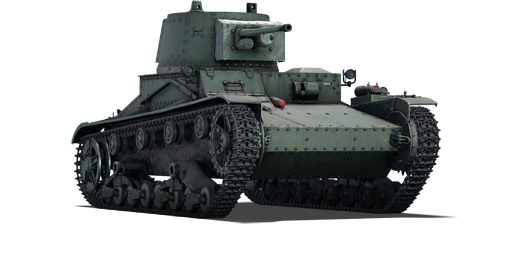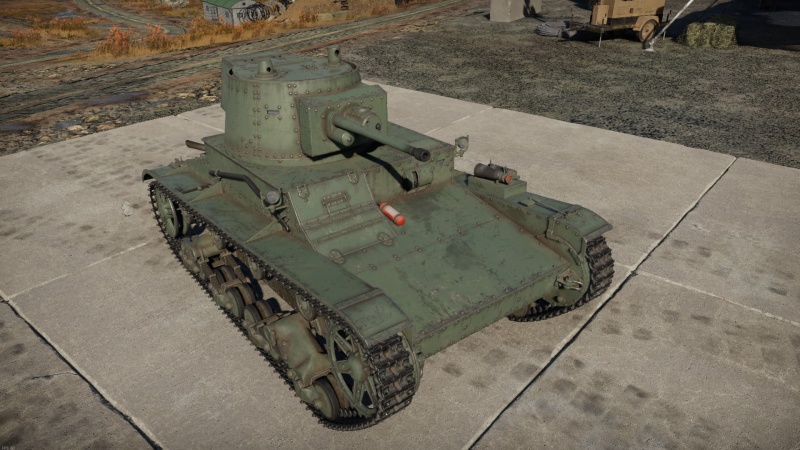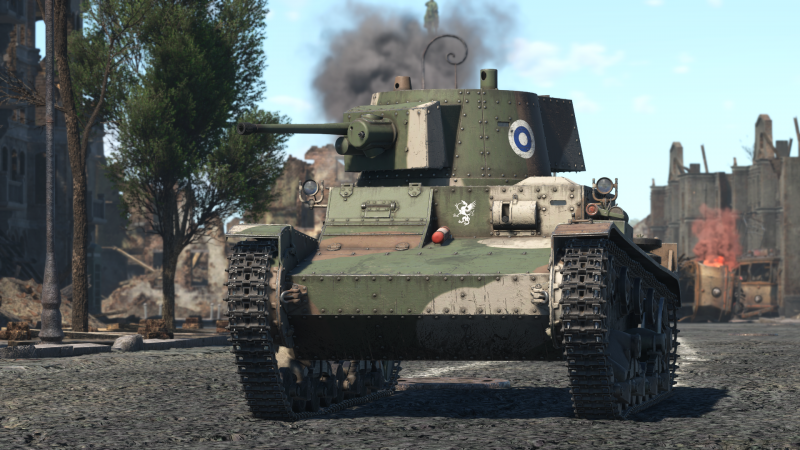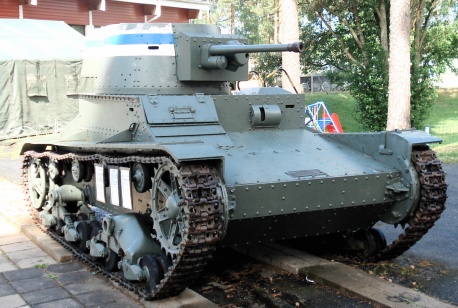Vickers Mk.E
| This page is about the Swedish light tank Vickers Mk.E. For the British machine gun, see Vickers E (7.7 mm). |
Contents
Description
The Vickers Mk.E was developed as a private venture by Vickers to create a lightweight, easy-to-maintain, and inexpensive light tank. Destined for infantry support, three variants were created: the Model A with two machine guns in independent turrets, the Model B with a QF 3 pounder 47 mm cannon, and the Vickers Medium Dragon, which was used as a cargo vehicle, mainly as an artillery tractor. While the British army did not use the Model A or B, it did use the Dragon model. The base variants found service in countries like China, India, Finland, and Poland. The vehicle even inspired the Polish 7TP (a modified Vickers Mk.E Model B) and the famous T-26, which was a licensed variant of the Vickers Mk.E with domestically made systems, such as optics and a 45 mm gun instead of the QF 3 pounder. The vehicle had very poor performance; however, it was developed in 1929 and used up until the 1940s. It's no surprise that it was severely outclassed by tanks like the Panzer III during the German-Soviet aggression against Poland and later on the Eastern Front, or against the T-34 during the Continuation War.
Introduced in Update "Fire and Ice", the Vickers Mk.E sits at a very low BR, with poor mobility and armament that might label it as a mediocre tank. However, it does have some advantages. Unlike American or French 37 mm cannons, the Vickers Mk.E features an APHE round with decent muzzle velocity, but with a very small amount of explosive filler (just 15g). The APHE round offers lower penetration values compared to the AP round, but this is less of an issue at Rank I where many vehicles have no armour, and long-range shots are challenging. Still, it is recommended to carry a small amount of AP rounds for heavier targets.
One of the Vickers Mk.E's significant strengths is its gun depression of 10 degrees, combined with a turret positioned higher than the hull. This configuration makes it easier to peak over hills compared to other tanks. However, escaping from dangerous situations is difficult due to its maximum reverse speed of only 3.6 km/h. Despite its very poor armour, the transmission is relatively large for its size and its position can sometimes deflect shots that might otherwise kill crew members or damage internal modules.
General info
Survivability and armour
The armour on the Vickers Mk.E can reliably stop only rifle-calibre munitions; however, some machine guns like the British 7.92 mm BESA or the German 7.92 mm MG34/42 can easily penetrate certain 10 mm plates. The unsloped armour plates, combined with their weak protection levels, lead to one conclusion: avoid getting shot at.
Unlike the T-26, the Vickers Mk.E is crewed by four members, which means that shells without explosive filler may not knock out the entire crew with one hit to the hull, giving you a small chance to fight back. However, it's not something to rely on too heavily.
Armour type:
- Rolled homogeneous armour
| Armour | Front | Sides | Rear | Roof |
|---|---|---|---|---|
| Hull | 10 mm (32°, 59°), 17.5 mm (1°) Upper plate 10 mm (80°) Upper glacis 17.5 mm (11°) Lower plate 10 mm (49°) Lower glacis 10 mm (9-59°) Driver's port |
10 mm | 17.5 mm (1°) Upper plate 10 mm (9°) Lower plate |
5 mm Hull 10 mm rear |
| Turret | 13.6 mm (10°) Turret front 13.6 mm (1-71°) Gun mantlet |
13.6 mm (10°) | 13.6 mm (9°) | 5 mm |
Notes:
- Tracks and suspension wheels are 15 mm thick
- Belly armour is 5 mm thick.
Mobility
The Vickers Mk.E has a cruise speed that allows it to keep up with most vehicles at its BR. While it won't achieve racing speeds, the tank can get you where you need to go in due time.
| Game Mode | Max Speed (km/h) | Weight (tons) | Engine power (horsepower) | Power-to-weight ratio (hp/ton) | |||
|---|---|---|---|---|---|---|---|
| Forward | Reverse | Stock | Upgraded | Stock | Upgraded | ||
| Arcade | 39 | 4 | 8.6 | 143 | 176 | 16.63 | 20.47 |
| Realistic | 36 | 4 | 81 | 92 | 9.42 | 10.7 | |
Modifications and economy
Most important modifications:
- All the protection tree upgrades
- pstkr 27-34 APHE round
- Horizontal Drive
- Engine and Transmission
Armaments
Main armament
The Vickers Mk.E is equipped with the 37 mm Psv.K/36, which is a fairly mediocre weapon in terms of performance. Despite its low calibre, it could be considered superior to American and German 37 mm cannons due to its APHE round.
| 37 mm Psv.K/36 | Turret rotation speed (°/s) | Reloading rate (seconds) | |||||||||||
|---|---|---|---|---|---|---|---|---|---|---|---|---|---|
| Mode | Capacity | Vertical | Horizontal | Stabilizer | Stock | Upgraded | Full | Expert | Aced | Stock | Full | Expert | Aced |
| Arcade | 50 | -10°/+20° | ±180° | - | 13.3 | 18.4 | 22.4 | 24.8 | 26.4 | 4.03 | 3.56 | 3.29 | 3.10 |
| Realistic | 8.3 | 9.8 | 11.9 | 13.2 | 14.0 | ||||||||
Ammunition
There are two available rounds:
- APHE round: Lower penetration but high damage potential.
- AP shell: Higher penetration but low damage potential.
It's advisable to carry a mix of both ammunition types. The APHE round can potentially knock out some enemy tanks, but it will be completely ineffective against heavily-armoured vehicles typically encountered when uptiered. For these tanks, it's best to use AP rounds and aim for crew members if possible.
| Penetration statistics | |||||||
|---|---|---|---|---|---|---|---|
| Ammunition | Type of warhead |
Penetration @ 0° Angle of Attack (mm) | |||||
| 10 m | 100 m | 500 m | 1,000 m | 1,500 m | 2,000 m | ||
| psav Vj4 | AP | 62 | 58 | 42 | 29 | 20 | 14 |
| pstkr 27-34 | APHE | 55 | 51 | 37 | 26 | 17 | 12 |
| Shell details | ||||||||||||
|---|---|---|---|---|---|---|---|---|---|---|---|---|
| Ammunition | Type of warhead |
Velocity (m/s) |
Projectile mass (kg) |
Fuse delay (m) |
Fuse sensitivity (mm) |
Explosive mass (TNT equivalent) (g) |
Ricochet | |||||
| 0% | 50% | 100% | ||||||||||
| psav Vj4 | AP | 810 | 0.74 | - | - | - | 47° | 60° | 65° | |||
| pstkr 27-34 | APHE | 800 | 0.74 | 1.2 | 9 | 15 | 47° | 60° | 65° | |||
Ammo racks
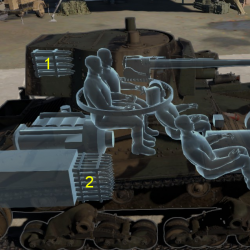
| Full ammo |
1st rack empty |
2nd rack empty |
Visual discrepancy |
|---|---|---|---|
| 50 | 43 (+7) | 1 (+49) | No |
Note:
- Shells are modeled individually and disappear after having been shot or loaded.
- Turret empty: 43 (+7) shells.
Machine guns
The small calibre of the ksp m/36 machine gun limits its effectiveness to damaging open-topped vehicles or engaging low-flying aircraft. However, its belt size allows for continuous firing at the enemy for at least 20 seconds.
| 8 mm ksp m/36 | ||||
|---|---|---|---|---|
| Mount | Capacity (Belt) | Fire rate | Vertical | Horizontal |
| Coaxial | 4,000 (250) | 649 | - | - |
Usage in battles
It is recommended to play the Vickers Mk.E in a support role, flanking the battlefield and finding a good position to assist teammates. The 37 mm cannon offers good characteristics, with both APHE and AP rounds capable of dealing significant damage to enemy vehicles at short and long ranges. The fast reload allows for quick aim adjustments between shots, making the Vickers Mk.E highly effective as a flanking vehicle if positioned well. Its 10 degrees of gun depression enables it to hide its hull and minimize visibility to the enemy, particularly when keeping back at long-range to avoid taking damage.
However, the lack of armour means it's vulnerable to heavy-calibre machine guns like the 12.7 mm M2HB and 13.2 mm Breda Model 31, which can penetrate its thickest armour plates. Therefore, it's crucial to avoid being targeted first by enemies and to drive under cover to evade detection.
Additionally, it's worth keeping in mind that the Vickers Mk.E has a slow reverse speed of -4 km/h, making retreats slower than advances. Awareness of enemy positions and available cover is vital to minimizing exposure to enemy fire.
Furthermore, be cautious of enemy aircraft equipped with bombs or powerful guns, as they can easily destroy the Vickers Mk.E. Staying near tree lines to avoid detection and relying on friendly SPAAs units for air defense is advisable, given the Vickers Mk.E's limited anti-aircraft capabilities.
Enemies worth noting:
- Pz.II and other tanks with autocannons can easily shred your armour and modules. It's best to avoid head-on engagements; if forced into one, try to fire first before they start spraying.
- SPAAs - Nearly every anti-aircraft vehicle at the tier can penetrate and destroy the Vickers Mk.E with ease, thanks to their high rates of fire. It's crucial to engage SPAAs preemptively. Certain underestimated SPAAs like the French P.7.T AA, CCKW 353 AA, and the American M15 CGMC should be noted, as their weapons are capable of efficiently disabling a Vickers Mk.E, despite lacking 20 mm autocannons.
- The D2 and some other French tanks have over 40 mm of armour, which can be difficult to penetrate at range or when angled. It's advised to avoid frontal engagements or shots beyond 500 m. Instead, move closer to increase penetration chances.
Pros and cons
Pros:
- The APHE round has adequate penetration and inflicts potent post-penetration damage.
- Very short reload time.
- Fairly accurate gun at short to medium ranges.
- Adequate gun depression.
- Favourable ammo rack positioning (reduces chance of ammo detonation).
Cons:
- Poor protection; side armour can be penetrated even by light machine guns.
- Struggles against better-armoured foes like the D2.
- Slow reverse speed.
- Poor turret traverse speed.
- Very bad acceleration from 0 km/h to cruise speed.
History
The Vickers Mk.E, also called the Vickers 6-ton, was a private venture by Vickers to develop a lightweight, inexpensive, and easy-to-maintain tank intended primarily for infantry support. Various variants were created, including one armed only with machine guns, another equipped with a QF 3-pounder (47 mm) gun and crewed by two members, and several variants developed by other nations.
For its time, it represented a revolutionary design and served as inspiration for many other tanks, such as the Polish 7TP, the Finnish variant of the Mk.E with a 37 mm cannon, and the famous T-26. The T-26, produced under license by the Soviet Union, featured minor modifications and the incorporation of domestically manufactured equipment, including a 45 mm gun in place of the QF 3-pounder.
The Mk.E was patented in 1929 and presented to the British government. Despite its innovative two-man turret, the British Armed Forces showed little interest, preferring a mix of medium/heavy tanks and lightly armoured tankettes. Vickers, however, saw great promise in the Mk.E and opted for proven concepts and equipment.
The tank utilized the reliable Armstrong Siddeley Puma, a petrol aviation-derived engine capable of 80-95 bhp (60-70 kW), achieving a speed of 22 mph (35 km/h). Its armour, consisting of riveted panels no thicker than 25 mm (1 inch), made it vulnerable to anti-tank rifles and autocannons but facilitated inexpensive production and easy repair without advanced tools.
Despite these characteristics, the vehicle failed to satisfy the British Armed Forces and found greater success in the international market. It was exported to countries including the USSR, Greece, Poland, Bolivia, Siam, Finland, Portugal, China, and Bulgaria. A total of 153 units of the Vickers Mk.E were produced, with most remaining in service until the 1940s, when their obsolescence became apparent.
A variant, the Vickers Medium Dragon, was also developed as a tracked cargo vehicle. Adopted in small numbers by the British Army as artillery tractors, it was also utilized by China, India, and Thailand in limited quantities.
Finland emerged as a primary operator of the Vickers Mk.E, replacing its aging Renault FTs with this new design. Initially, early test models performed poorly and were deemed unfit for combat by Finnish standards. However, the improved Vickers-Carden-Loyd Model 1933 exhibited significantly better cross-country performance and was actually praised for its ease of handling. Consequently, the B model, equipped with an anti-tank gun deemed superior to the A model's machine guns, was introduced into service.
An order for 32 tanks was placed at £4,500 each, omitting radio, optics, and armament to reduce costs. Deliveries occurred between 1937 and 1939, but many issues like the escalation in Europe, overheating problems with the engines and delivery delays resulted in only 10 tanks being ready by 1939, despite 26 being delivered.
Due to the lack of equipment, the tanks were outfitted with a licensed version of the 37 mm Bofors anti-tank gun, adapted for tank use with superior armour penetration capabilities compared to the 47 mm gun offered by Vickers. Home-made straight-through telescopic sights with simple crosshair reticles were produced and their poor quality proved lethal in combat, and were criticized by tank crews as junky and unpleasant. As a stopgap measure during the Winter War, some vehicles were armed with the same guns as Renault FTs, training tanks also used this configuration as well as an M/09-31 Maxim machine gun in a semi-coaxial housing on the right side of the Puteaux gun.
By 1941 and during the Continuation War, the remaining Vickers Mk.E were rearmed with Soviet 45 mm cannons that proved much more lethal, as well as 7.62 mm DT machine guns with a much higher rate of fire and more reliability. Despite these modifications, the tanks performed poorly during both conflicts, increasingly so as more advanced Soviet designs like the BT-7 and T-34 appeared on the battlefield.
The Vickers Mk.E's most notable engagement was during the Battle of Honkaniemi, where, after three hours, the attack was cancelled with less than half of the tanks reaching the starting point. Some became immobilized in rugged terrain, while others struggled with communication among allied forces. Five tanks were knocked out of the fight, but only one was able to be retrieved to the starting point. Finland's lack of experience with armoured formations, coupled with inadequate equipment such as poor optics, lack of radios, and inexperienced crews, proved fatal against the numerically superior Soviet forces at Honkaniemi.
Media
- Skins
See also
External links
- Vickers Mark E Type B in Finnish Service - Tank Encyclopedia
- Vickers 6-Ton (Mark E) 1929 - Tank-afv
- Vickers 6-ton - Wikipedia
| Vickers-Armstrongs Limited | |
|---|---|
| Ships | |
| Tribal-class | HMS Eskimo · HMCS Haida |
| Invincible-class | HMS Invincible* |
| Kongō-class | IJN Kongo** |
| Tanks | |
| Light Tanks | VFM5*** · Vickers Mk.11*** |
| Light Tank Mk VI | Light AA Mk I |
| Light Tank Mk VII | Tetrarch I |
| Light Tank Mk VIII | Alecto I |
| Tank, Infantry, Valentine | Valentine I · Valentine IX · Valentine XI · Archer |
| Vickers MBT | Vickers Mk.1 · Vickers Mk.3 · Vickers Mk.7*** |
| Heavy Tanks | Independent**** |
| Export | ▂МК-IX "Valentine" · Vickers Mk.E**** |
| See also | Vickers-Armstrongs Aircraft Limited |
| *Previously Armstrong Whitworth | |
| **Built for Japan | |
| ***Vickers Defence Systems | |
| ****Previously Vickers Limited | |
| Sweden light tanks | |
|---|---|
| L-60 | Strv m/38 · Strv m/39 · Strv m/39 TD · Strv m/40L |
| Strv m/41 | Strv m/41 S-I · Strv m/41 S-II |
| Ikv 91 | Ikv 91 · Ikv 91-105 |
| CV 90 | Strf 9040B · Strf 9040C · Strf 9040 BILL |
| CV 90105 · CV 90120 | |
| Wheeled | Pbil m/40 · U-SH 405 |
| Other | Strv m/31 · Strv 74 · Pbv 501 |
| Finland | Vickers Mk.E · ▄T-26E · BT-42 · ▄PT-76 · CV9030FIN · CT-CV 105HP |
| Denmark | CV9035DK |


